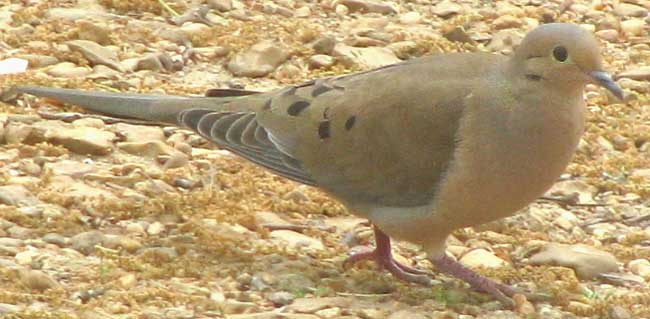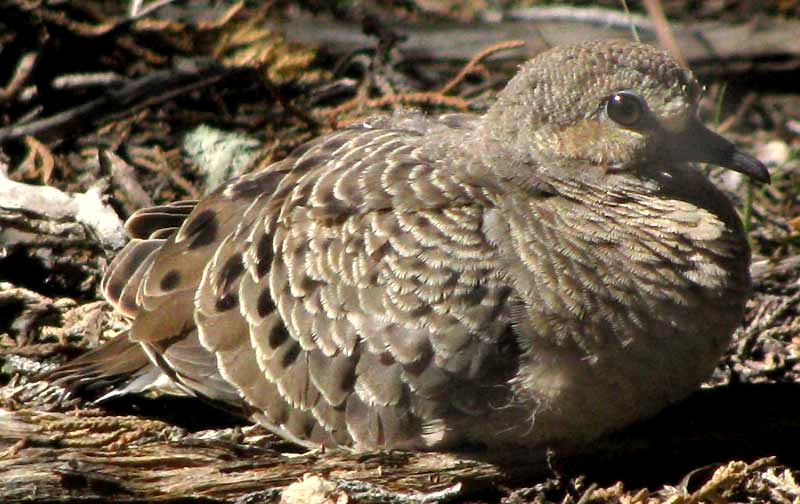Excerpts from Jim Conrad's
Naturalist Newsletter

from the the May 12, 2013 Newsletter issued from the Frio Canyon Nature Education Center in northern Uvalde County, southwestern Texas, on the southern border of the Edwards Plateau; elevation ~1750m (~5750 ft); N29.62°, W99.86°; USA
MOURNING DOVE MOURNING
Nowadays male doves call from every direction. Maybe the most ubiquitous call is that of the invasive Eurasian Collard Dove with his slow, ever-repeating, moody hoo-HOOOO-hoo, the syllables short-long-short, like Morse Code for the letter R, which back in my ham radio days meant "roger," so all day long it seems to me that doves call down from light lines "roger, roger, Jim, roger, message received, roger, roger... "
But recently another dovish calling has mingled with the rogers, a mellow, in fact mournful, ooo-AH-ooo-oo-oo, or short-long-short-short-short, which in ham radio Morse Code means "wait" or "hold on... "
At the top of this page you can see a male Mourning Dove on an electrical wire in mid ooo-AH-ooo-oo-oo with his neck inflated, with a bit of iridescence bringing even more attention to the neck, a part of the male dove's body the female apparently finds very interesting.
At a distance, Mourning Doves, ZENAIDA MACROURA, can be distinguished from our four other dove species by their long, sharp tails. Of the other four -- the Eurasian Collard, White-winged, Ground and Inca Doves -- only the Inca Dove's tail is long, but it's rounded, not sharp-pointed like the Mourning Dove's, plus the birds are much smaller, only 6.5 inches long to the Mourning Dove's 10.5.

from the the March 23, 2009 Newsletter, issued from the forest near Natchez, Mississippi; elevation ~400ft (120m), ~N31.47°, ~W91.29°:
MOURNING DOVE-S POINTED TAIL
Right after snapping the above junco picture a Mourning Dove, ZENAIDA MACROURA, sailed down next to me, so the resulting picture is shown above.
Mourning Doves are among the best-known North American birds, nesting in most of the US and Mexico, and during the summer migrating deep into Canada. They even turn up below birdfeeders in small towns and the suburbs. My field guide says they're absent only from extensively forested landscapes.
There's a lot of folksy discussion about Mourning Dove courtship behavior, nesting, eggs, young, plumages, food and more in the online AC Bent electronic book at http://www.birdsbybent.com/ch11-20/mourning.html.
Of the 12 North American pigeon and dove species profiled in the Smithsonian field guide, only the Mourning Dove has such a long, sharply pointed tail.
from the the April 28, 2013 Newsletter issued from the Frio Canyon Nature Education Center in northern Uvalde County, southwestern Texas, on the southern border of the Edwards Plateau; elevation ~1750m (~5750 ft); N29.62°, W99.86°; USA
MOURNING DOVE FLEDGLING

While I dug a trench for the new nature center's water pipes, Fred called to me that he'd spotted three sparrow-sized doves basking in the morning sunlight beneath low-hanging Ashe Juniper branches. Above you see one with his feathers fluffed up letting in warm sunshine and springy air.
At first we thought they were Inca Doves, common from the US Southwest through Mexico into Central America, and distinguished by their "scaly" appearance, caused by their feathers' dark edges. Our birds beneath the junipers looked scaly but once the picture was on the laptop's screen it was clear that the scaliness was caused by feathers that -- at least in their fluffed-out, back-lit state -- had pale margins, not dark ones.
Also, Inca Doves have long tails, but you can see that our bird's tail is a stubby little thing. And note the large, dark spots on some of the feathers. Inca Doves don't have such dark spots. That left Ground Doves, whose front parts are scally looking...
*UPDATE: But that was wrong, too. In 2024 when I upload the above photo to iNaturalist, user "scardif" recognized that this is what Mourning Dove fledglings look like. A cue to this is that the eye rim on the above bird is very slightly bluish, pointing to the Mourning Dove's blue eye rims, not the Common Ground Dove's white ones.